The Mission to Save Florida’s Reefs
Here’s how a sweeping reef restoration plan in the Florida Keys hopes to transform an ecological disaster into a great American comeback story.

A diver tending to elkhorn coral at the Coral Restoration Foundation’s Carysfort Reef nursery
Nearly a century ago, Carysfort Reef off the Florida Keys became the backdrop of the first-ever underwater color photograph. With their picture of a hogfish published in the July 1927 issue of National Geographic, botanist William H. Longley and photographer Charles Martin helped introduce coral reefs to landlubbers across the globe.
By the 1970s, Carysfort Reef had become a hot spot in the burgeoning sport diving industry, and for good reason. The reef was a vivid underwater forest and the backbone of a thriving marine ecosystem. Hundreds of species of fish, sharks, and dolphins darted through the reef while myriad invertebrates, like spiny lobsters and sea snails, clung to Carysfort’s various nooks and crannies and crawled through its lush plant and anemone life.
But today, Carysfort Reef is a bleached and disintegrating graveyard, a veritable shipwreck in the global coral crisis. Photographs taken of the reef over the past 40 years illustrate how warming waters, pollution, overfishing, disease, and rising acidity levels have taken steep tolls on the ecosystem. But scientists are hoping to give Carysfort and six other reefs in the Great Florida Reef system a shot at a comeback.
In late 2019, scientists at the National Oceanic and Atmospheric Administration (NOAA) embarked on “Mission: Iconic Reefs,” an effort to restore seven reef sites in the Florida Keys over the next 20 years. By growing hundreds of thousands of individual coral fragments in nurseries and then moving those corals out onto the reef, they hope to cover an area just larger than the size of 52 football fields with new coral growth.
Tom Moore, NOAA’s co-lead for the project says, “We want to turn that time series around and add new pictures to that montage of decline—to show that we can create real recovery.”
It’s Now or Never
The Great Florida Reef is the world’s third-largest barrier reef. The only one in North America, it runs along the Atlantic side of the Florida Keys for its entire 358-mile stretch and helps protect the islands from storm surges, absorbing a whopping 97 percent of wave energy. The reef also generates billions of dollars, supporting one out of every two jobs in the Keys and attracting nearly five million visitors each year for activities like diving, snorkeling, and fishing.
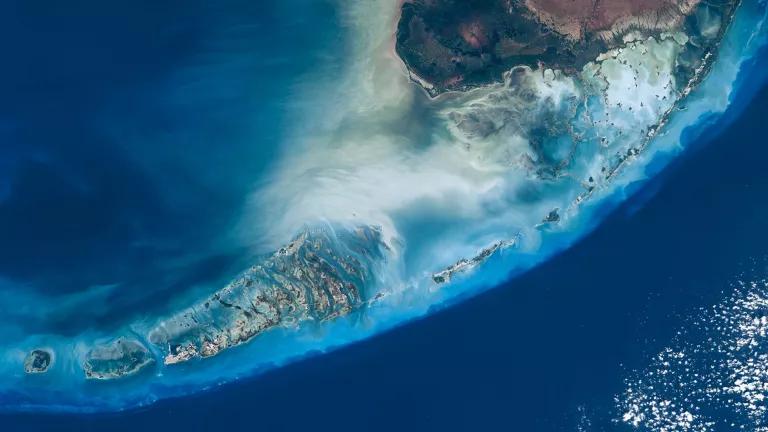
Across much of the seven reef sites, coral currently covers a mere 2 percent of the ocean floor—a dramatic decline from the area’s historic average of 25 percent. In some spots, the reef has lost more than 98 percent of its once-dominant coral species, staghorn and elkhorn, within just decades. Without immediate action, the long-term prognosis is even more dire: The Intergovernmental Panel on Climate Change (IPCC) has warned that all of the world’s coral reefs could be lost if the world warms 2 degrees Celsius above preindustrial temperatures—a stone’s throw from the 1.1 degrees it’s already warmed. Avoiding that fate will require, according to the latest IPCC report, an all-hands-on-deck climate approach.
“I’ve been diving more than 25 years. I’ve been all over the world, and I’ve never seen a reef in such poor shape,” says Alice Grainger, communications director for the Coral Restoration Foundation (CRF), one of the local partners working with NOAA on the project. “It’s a national treasure—and it’s on the brink of extinction.”
The Birthplace of Reef Restoration
Beginning seven years ago, exceptionally warm waters from El Niño triggered the longest-lasting and most damaging bleaching event ever recorded. Within three years, 30 percent of the world’s corals had been wiped out. Bleaching events occur when a stressful environment—for example, warmer-than-average water temperatures—causes corals to expel the colorful, symbiotic algae that live within them and provide them with oxygen and nutrients. That same year, scientists discovered the first-ever case of stony coral tissue loss disease in Virginia Key off the coast of Miami-Dade County. The disease, which spreads quickly through colonies and can kill coral within weeks, continues to plague more than 30 coral species across the Keys and the Caribbean.
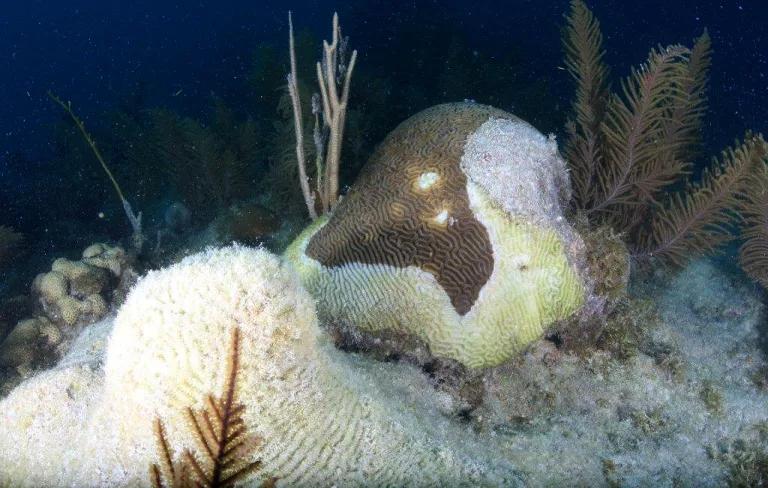
For many years, NOAA didn’t consider reef restoration a major conservation tool. But after reefs began experiencing huge die-offs, Moore says, “We realized that, if we wait, we’re not going to have any reefs left to restore.”
A wave of federal investments in reef protections soon dovetailed with emerging marine science coming out of Florida from groups like CRF, Mote Marine Laboratory & Aquarium, and the Florida Aquarium, all of which are now partners on the NOAA project. “The Keys were really one of the birthplaces of reef restoration work,” says reef restoration program manager Jessica Levy, who helps share CRF’s expertise and research with other conservation and restoration groups.
Eventually, Mission: Iconic Reefs emerged as a possible way to unify the groups’ efforts. The initiative’s point was not to choose only the most damaged reefs but rather reefs with a mix of both ecological and social value that the team had a good shot at recovering. Newfound Harbor off Big Pine Key, for example, sits adjacent to a popular marine science camp for teenagers, where many budding marine scientists have stuck their heads under the water to see a reef for the first time.
“These places were iconic once, but they’ve now been iconic poster children of decline,” Moore says. He now hopes they will become symbols of the potential for reef restoration.
The Science of Reef Restoration
Off the coast of Key West, hundreds of Christmas tree–shaped structures hang in the water, tethered to the ocean floor on one end with buoys on the other. Tens of thousands of coral fragments dangle like ornaments from their PVC-pipe branches, absorbing light and nutrients from the water column. This is one of CRF’s seven offshore nurseries, where, in less than a year, finger-size fragments of corals grow into genetic replicas of their parents via a process of asexual reproduction called fragmentation.
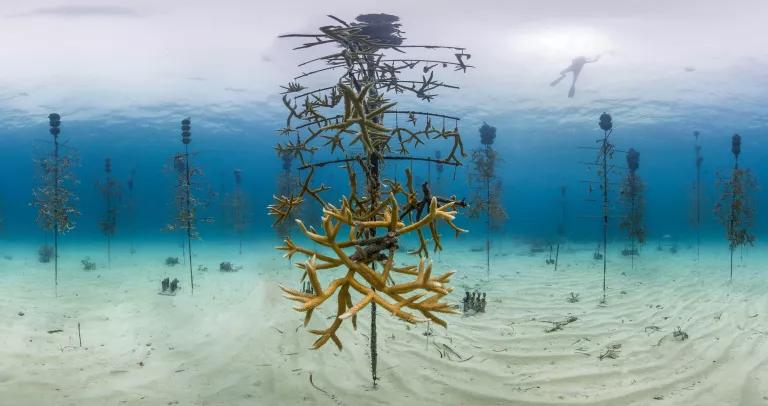
“The trees are now being used by groups all around the world because they’re the best way of growing particular species of corals quickly in a small footprint,” Levy says.
Once big enough, divers meticulously transfer these fragments to the reef, onto which the pieces permanently fuse—a slow-going process that the teams are working to make faster by improving things like the type of reef-friendly superglues they use.
The nurseries allow the groups growing corals for the project, including CRF, to produce hundreds of thousands of reef-ready staghorn and elkhorn corals each year. Once the predominant coral species in the region, the two corals were classified as critically endangered in 2008 by the International Union for Conservation of Nature. In the earlier stages of the project, NOAA will focus predominantly on fast-growing staghorn and elkhorn corals, branching them with limestone skeletons that build atop one another to provide reef structure and habitat for other marine species, such as nurse sharks, sea turtles, and eels. “It’s like putting the trees back into the forest,” Moore says. Another huge plus: Staghorn and elkhorn are immune to stony coral tissue loss disease.
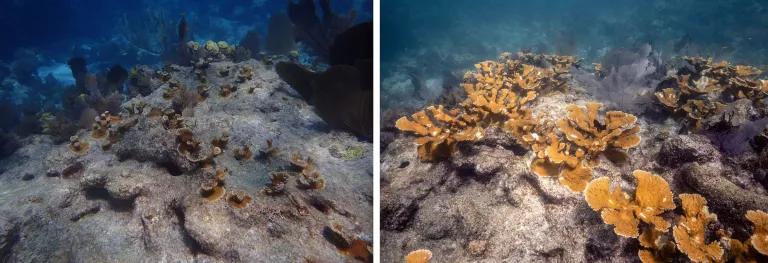
But not every species of coral can be grown in nurseries through fragmentation. For instance, it doesn’t work as well for the rounded and far-slower-growing brain corals, which will be included in later stages of the project, along with star and pillar corals. Brain corals only grow a few centimeters each year, and in the wild, these corals tend to reproduce sexually.
(All corals have the ability to reproduce sexually, most of which do so through a process called spawning—a nearly romantic event triggered by environmental cues such as light and temperature. Staghorn corals, for example, release trillions of sperm and eggs into the sea on a single night in late summer, under a full moon.)
To grow species like the brain coral, marine scientists are now using newer techniques called “microfragmentation” and “skinning” in which dozens of paper-thin fragments of corals, akin to blades of grass, are laid on top of either an artificial, rounded structure or a dead coral head until they fuse together as a new “skin.” The process allows them to re-create the structure of a basketball-size brain coral in close to two years, when it would’ve otherwise taken 10 years to grow that big on its own.
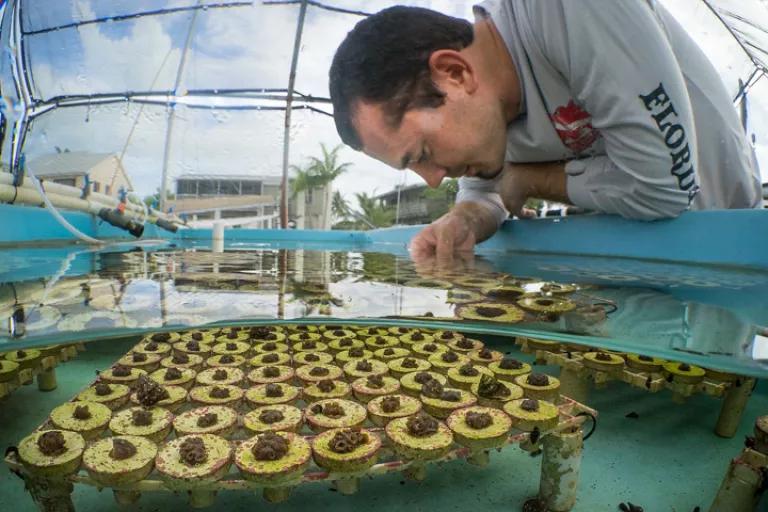
In the project’s final stage, NOAA plans to reintroduce species of coral that are either rarer in the ecosystem or more sensitive to stony coral tissue loss disease, like finger or blade corals. In some cases, the science needed to propagate these rarer corals is still being developed. “Think of them like the decorative plant in your garden,” Moore says. The species of corals that make up the bulk of the restoration work are, by comparison, the thickets of trees making up the forest. By the end of the 20-year project, the team expects the reef to rebound to 25 percent coral cover.
But growing the corals is only half the battle. The scientists must also make sure the reef environment is as welcoming as possible. This means taking stock of invasive species, such as the space-hogging invertebrate palythoa; addressing algal overgrowth by introducing algae-eating herbivores like sea urchins and king crabs; and having a team of divers to conduct routine maintenance.
Diversifying the Reef
Quantity, of course, isn’t everything. Genetic diversity has plummeted in the Keys’ corals in recent decades, and diversity—both in species variety and the gene pools represented within those species—is paramount for long-term resiliency and health. In some places, even reefs with sufficient coral cover aren’t functionally healthy because they consist largely of the same genotype. “When it comes to reef reproduction, it’s a dead end at that point,” Moore says.
In 2018, the Coral Restoration Consortium—a collection of reef scientists and advocates that include many of the partners now working on Mission: Iconic—made the first-ever attempt at something called “assisted gene flow” in corals, a process of sexually breeding corals from two regions (far enough from each other that sexual reproduction was never before in the cards) to see if they could fold in traits that would make corals more resilient to future stressors, like warming waters and disease outbreaks.
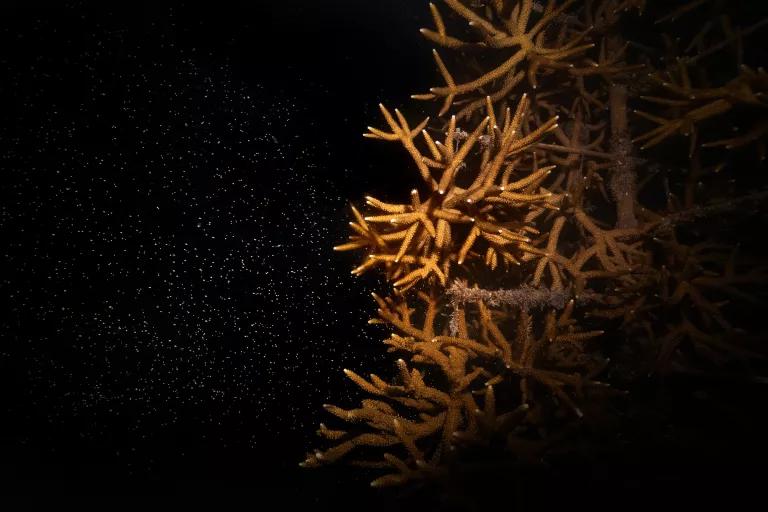
With flash-frozen sperm of elkhorn corals from Florida and Puerto Rico in tow, scientists flew to the Caribbean in August to mix the sperm with fresh eggs from elkhorn corals in Curaçao. Divers then raced to bring the newly fertilized larvae back to a lab in Florida, where the resulting corals would grow in a land-based nursery. “Now we’re doing more research to see whether these regional combinations are any more resilient to things like disease or bleaching,” Moore says.
Since that successful trial run, those scientists have created hundreds of new coral genotypes, and as the findings on those genetic recombinations pour in, NOAA and its Mission: Iconic partners are better understanding how to get more resilient corals out onto the reef.
And the sooner the better, since the threats to reefs worldwide loom heavier each year.
“The local stressors we can try to control. We can educate people. We can improve water quality. But the global stressors, we need the powers that be to work on those,” says Grainger, who spent her childhood diving at reefs in the Red Sea. “The coral feels like a member of my own family, or my own body, almost.”
Grainger bristles, however, when the coral restoration project is called a Hail Mary pass for Florida’s reefs, because it implies a long shot based on luck. “It’s a Hail Mary in one respect—in that it absolutely has to happen if we don’t want this reef to be functionally extinct—but it’s not a Hail Mary in that we know that this works,” she says. “We just really need everyone to get behind it.”
This NRDC.org story is available for online republication by news media outlets or nonprofits under these conditions: The writer(s) must be credited with a byline; you must note prominently that the story was originally published by NRDC.org and link to the original; the story cannot be edited (beyond simple things such as grammar); you can’t resell the story in any form or grant republishing rights to other outlets; you can’t republish our material wholesale or automatically—you need to select stories individually; you can’t republish the photos or graphics on our site without specific permission; you should drop us a note to let us know when you’ve used one of our stories.

Can Anything Be Done to Stop Overfishing?
The Fate of This Coral Species Rests in a Dark Room in Tampa
How to Become a Community Scientist
Can Anything Be Done to Stop Overfishing?
The Fate of This Coral Species Rests in a Dark Room in Tampa
How to Become a Community Scientist
Can Anything Be Done to Stop Overfishing?
The Fate of This Coral Species Rests in a Dark Room in Tampa
How to Become a Community Scientist
Can Anything Be Done to Stop Overfishing?
The Fate of This Coral Species Rests in a Dark Room in Tampa